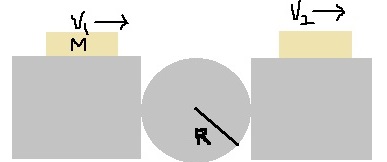You are required to read the code of conduct before posting. They are same as the forum rules. Click here to receive forum post(s) by email.
Physics : Rotational Motion
A block of mass M is initially moving to the right without friction with speed V1. It passes over the cylinder to the other position on right,when it first makes contact with the cylinder, it slips but the friction is large enough so that slipping ceases before M loses contact with the cylinder. The final velocity V2 of the block will be?(If radius of cylinder is R and its moment of inertia is I and initially at rest.)

Work,energy and power
Suppose a particle is moving along x-axis with constant velocity.A force directed along y-axis starts acting on the particle.As the particle accelerates along y-direction its velociy increases along y-direction..So the net velocity increases.But why is it written in textbooks that speed remains constant?And it is also written that kinetic energy remains constant.But that is increasing.
Failure of wrok energy theorem
Suppose a disc of radius a placed on the ground with uniform surface charge density s with its axis vertical.A charged particle is dropped from a height H from the ground along the axis of the disc.Initially the particl is at rest so initial kinetic energy is equal to zero.Then see the point when the electric force on the particle is equal to the gravitational force.At that point velocity of the particle is zero.Hence the change in kinetic energy is equal to zero.So the work done by the net external force should be zero.But the resultant force is causing a net displacement in the downward direction.So there has to be some work done by the net external force.Please explain this.
all real solution.
Functions
The conditions of two functions being equal:
(1)Ranges should be equal
(2)Domains should be equal
Now my doubt is, let one function be sinx and the other be cosx,then we have the ranges and the domains of both the functions to be equal.But these are not equal functions.Please explain it.
Solve this system of Equation
System of equations ::
1. v1^2*u1 + 2*v1*v0 + f3*u0 - f3*u1^2 + f2*u1 - f1 - u0^2 +
3*u0*u1^2 - u1^4 = 0
2. - v1^2*u0 + v0^2 - f3*u0*u1 + f2*u0 - f0 + 2*u0^2*u1 -
u0*u1^3 = 0
3. 2*u1*k1^2 = -1 + 2*k0*k1 + u1*k1^2
4. (2*u0 + u1^2)*k1^2 = k0^2 + u0*k1^2 + u1 + 2*k0*u1*k1 + 2*v1*k1
5. 2*u0*u1*k1^2 = -f3 + u0 + 2*k0*u0*k1 + k0^2*u1 - u1^2 + 2*v0*k1 + 2*k0*v1
6. u0^2*k1^2 = -f2 + k0^2*u0 + f3*u1 - 2*u0*u1 + u1^3 + 2*k0*v0 + v1^2
where variables are v1,v0,u0,u1,k0,k1 and f3,f2,f1,f0 are constants...
Mathematics : Probability
com
A gun is mounted on a gun carriage movable on a smooth horizontal plane.The gun is elevated at an angle 'a' to horizon.A shot is fired and leaves the gun in a direction inclined at an angle 'b' to horizon . if the mass of the gun and the carriage is n times that of the shot then show that
tan b = [1+1/n]tan a
Physics-Kinematics
Also, how does the direction of acceleration change, due to angular acceleration?
Thank you